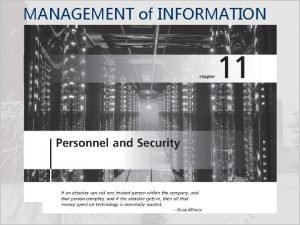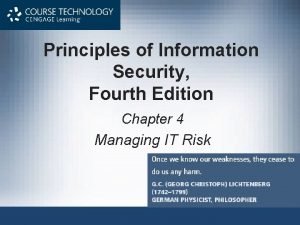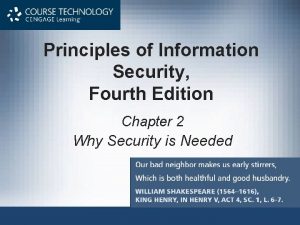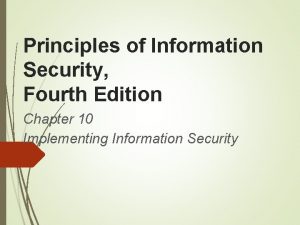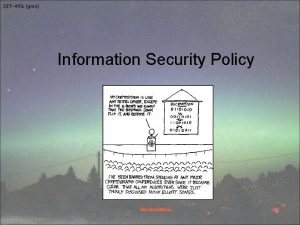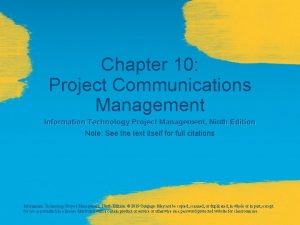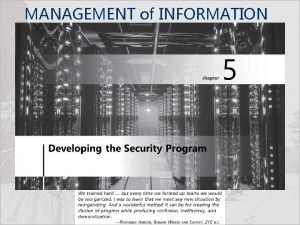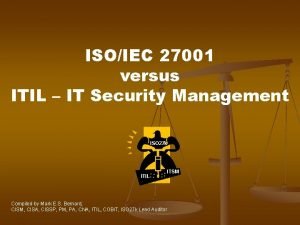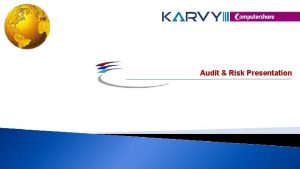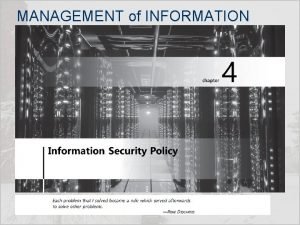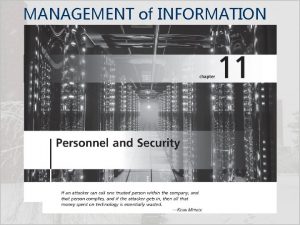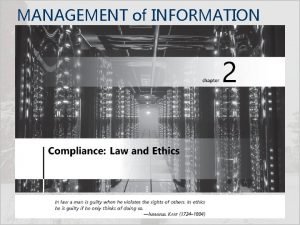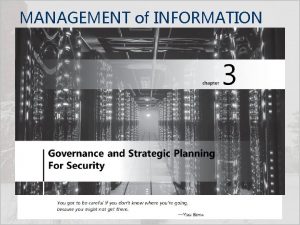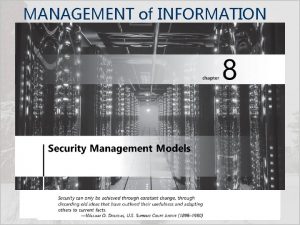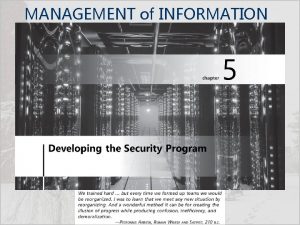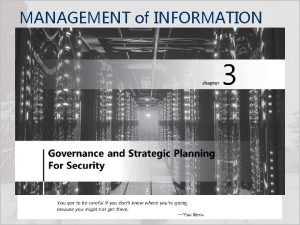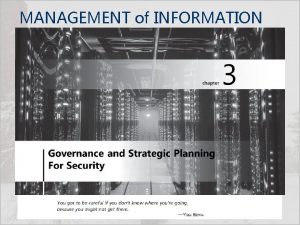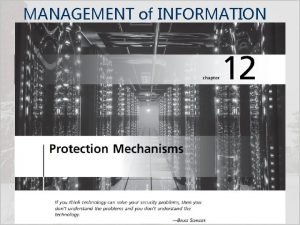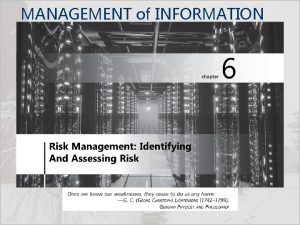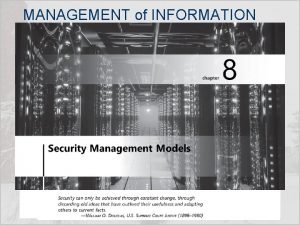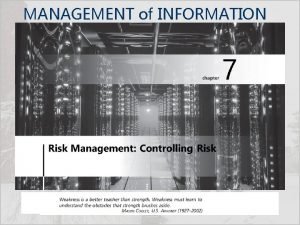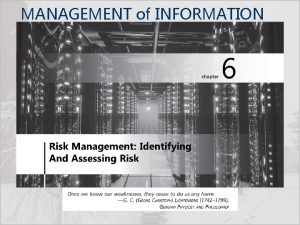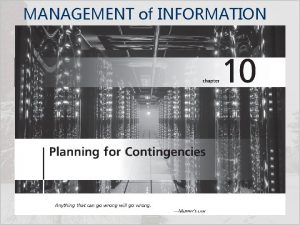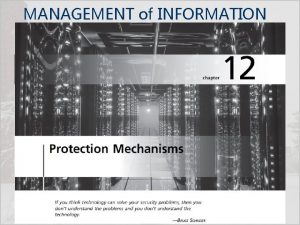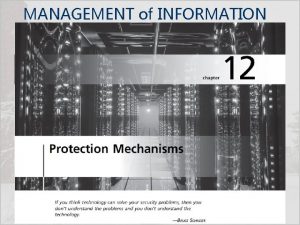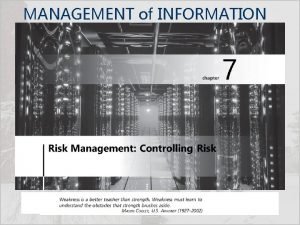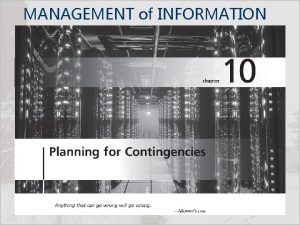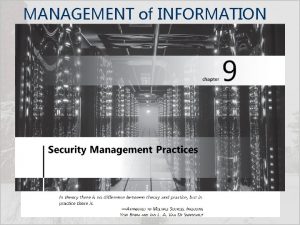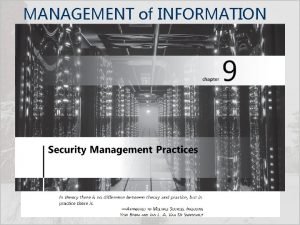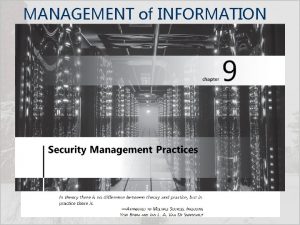MANAGEMENT of INFORMATION SECURITY Fifth Edition Security Policy
































- Slides: 32

MANAGEMENT of INFORMATION SECURITY, Fifth Edition

Security Policy - 1 Management of Information Security, 5 th Edition, © Cengage Learning 2

Introduction • Policy is the essential foundation of an effective information security program: – The success of an information resources protection program depends on the policy generated, and on the attitude of management toward securing information on automated systems – You, the policy maker, set the tone and the emphasis on how important a role information security will have within your agency – Your primary responsibility is to set the information resource security policy for the organization with the objectives of reduced risk, compliance with laws and regulations and assurance of operational continuity, information integrity, and confidentiality Management of Information Security, 5 th Edition, © Cengage Learning 3

Why Policy? • A quality information security program begins and ends with policy • Policies are the least expensive means of control and often the most difficult to implement • Some basic rules must be followed when shaping a policy: – Policy should never conflict with law – Policy must be able to stand up in court if challenged – Policy must be properly supported and administered Management of Information Security, 5 th Edition, © Cengage Learning 4

Why Policy? • According to Bergeron and Bérubé, the following guidelines can help in the formulation of IT policy as well as Info. Sec policy: – All policies must contribute to the success of the organization – Management must ensure the adequate sharing of responsibility for proper use of information systems – End users of information systems should be involved in the steps of policy formulation Management of Information Security, 5 th Edition, © Cengage Learning 5

The Bulls-eye Model Management of Information Security, 5 th Edition, © Cengage Learning 6

Policy Centric Decision Making • Bulls-eye model layers: – Policies — first layer of defense – Networks — threats first meet the organization’s network – Systems — computers and manufacturing systems – Applications — all applications systems • Policies are important reference documents for internal audits and for the resolution of legal disputes about management's due diligence [and] policy documents can act as a clear statement of management's intent Management of Information Security, 5 th Edition, © Cengage Learning 7

Policy, Standards, and Practices • Policy is a set of “Organizational guidelines that dictate certain behavior within the organization” • A Standard is “A detailed statement of what must be done to comply with policy, sometimes viewed as the rules governing policy compliance” • Guidelines are “Non-mandatory recommendations the employee may use as a reference in complying with a policy” • Procedures are “Step-by-step instructions designed to assist employees in following policies, standards and guidelines” • Practices are “Examples of actions that illustrate compliance with policies” Management of Information Security, 5 th Edition, © Cengage Learning 8

Policy, Standards, and Practices • Policies define what you can do and not do, whereas the other documents focus on the how • For policies to be effective they must be: – properly disseminated – read – understood – agreed-to – uniformly enforced Management of Information Security, 5 th Edition, © Cengage Learning 9

Policies, Standards, & Practices Management of Information Security, 5 th Edition, © Cengage Learning 10

Policy, Standards, and Practices • Policies require constant modification and maintenance • In order to produce a complete information security policy, management must define three types of information security policy: – Enterprise information security program policy – Issue-specific information security policies – Systems-specific policies Management of Information Security, 5 th Edition, © Cengage Learning 11

Enterprise Information Security Policy (EISP) • Enterprise information security policy (EISP) is that high-level information security policy that sets the strategic direction, scope, and tone for all of an organization’s security efforts • An EISP is also known as a security program policy, general security policy, IT security policy, high-level Info. Sec policy, or simply an Info. Sec policy Management of Information Security, 5 th Edition, © Cengage Learning 12

EISP Elements • An enterprise information security policy (EISP) assigns responsibilities for the various areas of Info. Sec, including maintenance of Info. Sec policies and the practices and responsibilities of end users • In particular, the EISP guides the development, implementation, and management requirements of the Info. Sec program, which must be met by Info. Sec management and other specific security functions Management of Information Security, 5 th Edition, © Cengage Learning 13

Integrating an Organization’s Mission and Objectives into the EISP • The EISP plays a number of vital roles, not the least of which is to state the importance of Info. Sec to the organization’s mission and objectives • The EISP should not contradict the organizational mission statement • However, it would be prudent for an institution to have policies that govern access and ensure that such access does not interfere or create a hostile work environment for other employees Management of Information Security, 5 th Edition, © Cengage Learning 14

EISP Elements • An overview of the corporate philosophy on security • Information on the structure of the Info. Sec organization and individuals who fulfill the Info. Sec role • Fully articulated responsibilities for security that are shared by all members of the organization (employees, contractors, consultants, partners, and visitors) • Fully articulated responsibilities for security that are unique to each role within the organization Management of Information Security, 5 th Edition, © Cengage Learning 15

EISP Elements Management of Information Security, 5 th Edition, © Cengage Learning 16

Issue-Specific Security Policy (ISSP) • An Issue-specific security policy (ISSP) is – An organizational policy that provides detailed, targeted guidance to instruct all members of the organization in the use of a resource, such as one of its processes or technologies • An issue-specific security policy (ISSP) is designed to regulate the use of some technology or resource issue within the organization • In some organizations, ISSPs are referred to as fair and responsible use policies, describing the intent of the policy to regulate appropriate use • The ISSP should assure members of the organization that its purpose is not to establish a foundation for administrative enforcement or legal prosecution but rather to provide a common understanding of the purposes for which an employee can and cannot use the resource Management of Information Security, 5 th Edition, © Cengage Learning 17

Issue-Specific Security Policy (ISSP) • An effective ISSP accomplishes the following: – It articulates the organization’s expectations about how its technology-based system should be used – It documents how the technology-based system is controlled and identifies the processes and authorities that provide this control – It indemnifies the organization against liability for an employee’s inappropriate or illegal use of the system • Every organization’s ISSPs should: – Address specific technology-based systems – Require frequent updates – Contain an issue statement on the organization’s position on an issue Management of Information Security, 5 th Edition, © Cengage Learning 18

Issue-Specific Security Policy (ISSP) ISSP topics could include use of: • • Electronic mail, IM and other communications apps Use of the Internet, the Web, and company networks Malware protection requirements Non-organizationally issued software or hardware on organization assets Organizational information on nonorganizationally owned computers Prohibitions against hacking or testing security controls or attempting to modify or escalate privileges Personal and/or home use of company equipment • • Removal of organizational equipment from organizational property Personal equipment on company networks Personal technology during work hours Organizational telecommunications technologies and networks Photocopying and scanning equipment Company information while outside company facilities Access control credentials by users Management of Information Security, 5 th Edition, © Cengage Learning 19

Elements of the ISSP • Statement of Purpose – Scope and Applicability – Definition of Technology Addressed – Responsibilities • Authorized Access and Usage of Equipment – User Access – Fair and Responsible Use – Protection of Privacy • Prohibited Usage of Equipment – – – Disruptive Use or Misuse Criminal Use Offensive or Harassing Materials Copyrighted, Licensed or other Intellectual Property Other Restrictions Management of Information Security, 5 th Edition, © Cengage Learning 20

Elements of the ISSP • Systems Management – – – Management of Stored Materials Employer Monitoring Virus Protection Physical Security Encryption • Violations of Policy – Procedures for Reporting Violations – Penalties for Violations • Policy Review and Modification – Scheduled Review of Policy and Procedures for Modification • Limitations of Liability – Statements of Liability or Disclaimers Management of Information Security, 5 th Edition, © Cengage Learning 21

Implementing the ISSP • Common approaches: – a number of independent ISSP documents – a single comprehensive ISSP document – a modular ISSP document that unifies policy creation and administration • The recommended approach is the modular policy, which provides a balance between issue orientation and policy management Management of Information Security, 5 th Edition, © Cengage Learning 22

Systems-Specific Security Policy • Systems-Specific Security Policies (Sys. SPs) sometimes have a different look and may seem more like procedures to some readers • They may often function as standards or procedures to be used when configuring or maintaining systems • Sys. SPs can be separated into: – Managerial guidance – Technical specifications Or combined in a single unified Sys. SP document Management of Information Security, 5 th Edition, © Cengage Learning 23

Managerial Guidance Sys. SPs • Created by management to guide the implementation and configuration of technology • Applies to any technology that affects the confidentiality, integrity or availability of information • Informs technologists of management intent Management of Information Security, 5 th Edition, © Cengage Learning 24

Technical Specifications Sys. SPs • System administrators directions on implementing managerial policy • Each type of equipment has its own type of policies • There are two general methods of implementing such technical controls: – access control lists – configuration rules Management of Information Security, 5 th Edition, © Cengage Learning 25

Access Control Lists (ACLs) • Include the user access lists, matrices, and capability tables that govern the rights and privileges • A capability table specifies which subjects and objects that users or groups can access • These specifications are frequently complex matrices, rather than simple lists or tables • In general ACLs enable administrations to restrict access according to user, computer, time, duration, or even a particular file Management of Information Security, 5 th Edition, © Cengage Learning 26

ACLs • In general ACLs regulate: – Who can use the system – What authorized users can access – When authorized users can access the system – Where authorized users can access the system from – How authorized users can access the system Management of Information Security, 5 th Edition, © Cengage Learning 27

Windows ACLs Management of Information Security, 5 th Edition, © Cengage Learning 28

Linux ACL Management of Information Security, 5 th Edition, © Cengage Learning 29

Configuration Rules • Configuration rules are instructional codes that guide the execution of the system when information is passing through it • Rule policies are more specific to the operation of a system than ACLs, and may or may not deal with users directly • Many security systems require specific configuration scripts telling the systems what actions to perform on each set of information they process Management of Information Security, 5 th Edition, © Cengage Learning 30

Firewall Configuration Rules Management of Information Security, 5 th Edition, © Cengage Learning 31

Combination Sys. SPs • Many organizations create a single document combining elements of both Management Guidance and Technical Specifications Sys. SPs • While this document can be somewhat confusing to the users of the policies, it is very practical to have the guidance from both perspectives in a single place • Such a document should carefully articulate the required actions for each procedure described Management of Information Security, 5 th Edition, © Cengage Learning 32
 Management of information security 5th edition
Management of information security 5th edition Principles of marketing fifth european edition
Principles of marketing fifth european edition Appraisals in lazarus theory of emotion
Appraisals in lazarus theory of emotion Fundamentals of corporate finance fifth edition
Fundamentals of corporate finance fifth edition Democritus atomic model diagram
Democritus atomic model diagram Molecular biology
Molecular biology Molecular biology of the cell fifth edition
Molecular biology of the cell fifth edition Human anatomy fifth edition
Human anatomy fifth edition Human anatomy fifth edition
Human anatomy fifth edition Failure of supporting utilities and structural collapse
Failure of supporting utilities and structural collapse Principle of information system
Principle of information system Information asset classification worksheet
Information asset classification worksheet Principles of information security 4th edition
Principles of information security 4th edition Principles of information security 4th edition
Principles of information security 4th edition Security policy and integrated security in e-commerce
Security policy and integrated security in e-commerce Xkcd specifications
Xkcd specifications Information technology project management 9th edition
Information technology project management 9th edition Blue project chapter 5
Blue project chapter 5 Vertical
Vertical Information technology project management 8th edition
Information technology project management 8th edition Project management chapter 6
Project management chapter 6 Introduction to information systems 5th edition
Introduction to information systems 5th edition The time/space collaboration and social tool matrix
The time/space collaboration and social tool matrix Information technology project management 9th edition
Information technology project management 9th edition Using mis (10th edition) 10th edition
Using mis (10th edition) 10th edition Mis
Mis Privatesecurity
Privatesecurity Visa international security model
Visa international security model Information security
Information security Chapter 9 information management and security
Chapter 9 information management and security Project management for information security
Project management for information security Iso 27001 itil
Iso 27001 itil Information security management
Information security management
